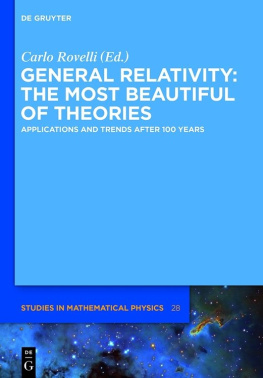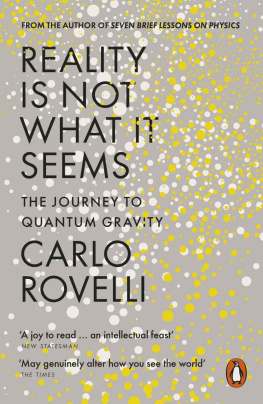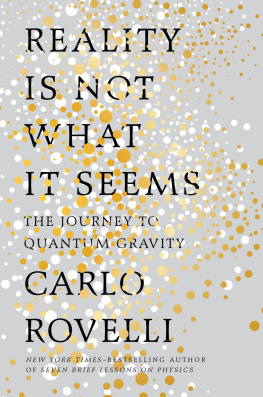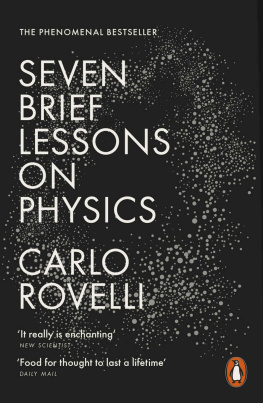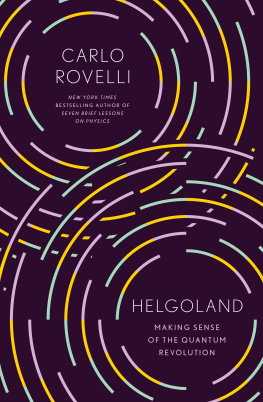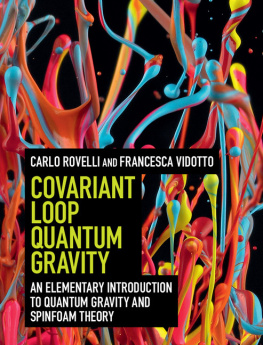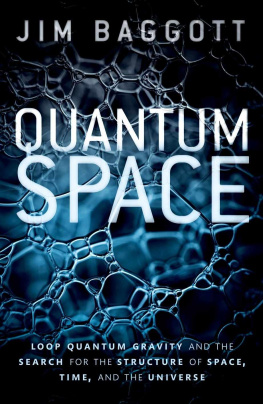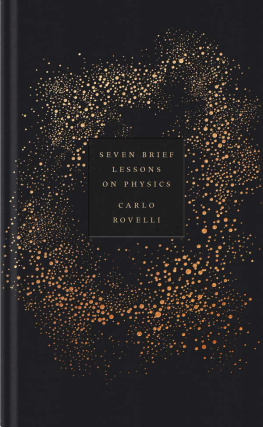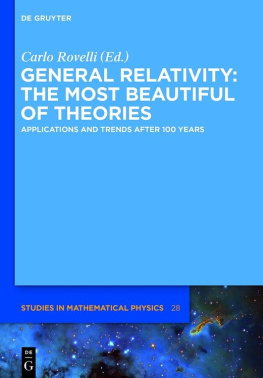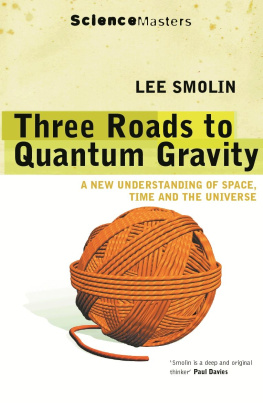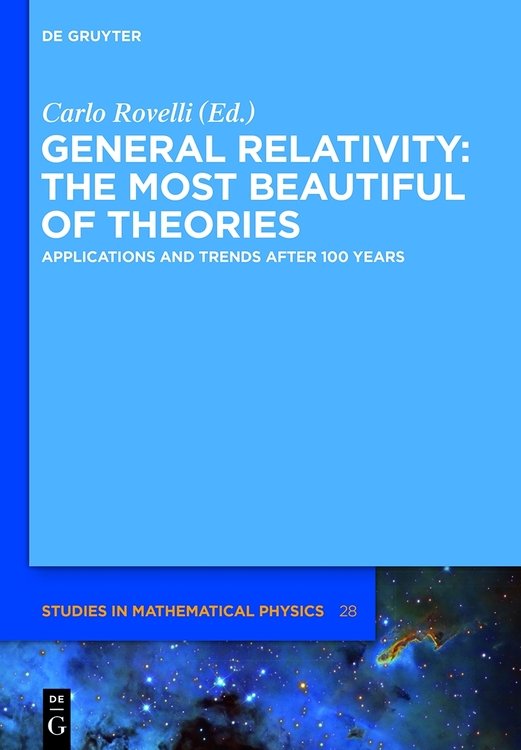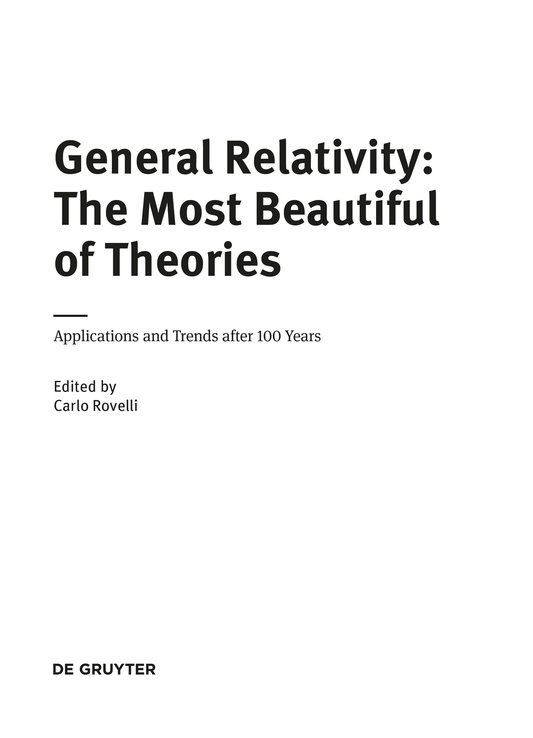De Gruyter Studies in Mathematical Physics
Edited by
Michael Efroimsky, Bethesda, Maryland, USA
Leonard Gamberg, Reading, Pennsylvania, USA
Dmitry Gitman, So Paulo, Brazil
Alexander Lazarian, Madison, Wisconsin, USA
Boris Smirnov, Moscow, Russia
Volume 28
Physics and Astronomy Classification Scheme 2010
04.20.-q, 04.60.-m
Editor
Prof. Dr. Carlo Rovelli
Centre de Physique Thorique de Luminy
Aix-Marseille University
Case 907, Luminy
13288 Marseille, France
rovelli@cpt.univ-mrs.fr
ISBN 978-3-11-034042-6
e-ISBN (EPUB) 9783110383645
e-ISBN (PDF) 978-3-11-034330-4
e-ISBN (EPUB) 978-3-11-038364-5
Set-ISBN 978-3-11-034331-1
ISSN 2194-3532
Library of Congress Cataloging-in-Publication Data
A CIP catalog record for this book has been applied for at the Library of Congress.
Bibliographic information published by the Deutsche Nationalbibliothek
The Deutsche Nationalbibliothek lists this publication in the Deutsche Nationalbibliografie; detailed bibliographic data are available on the Internet at http://dnb.dnb.de .
2015 Walter de Gruyter GmbH, Berlin/Munich/Boston
Typesetting: le-tex publishing services GmbH, Leipzig
Printing and binding: CPI books GmbH, Leck
www.degruyter.com
Epub-production: Jouve, www.jouve.com
Carlo Rovelli
The most beautiful physical theory
The most beautiful of all existing theories.
Landau and Lifshitz
Probably the greatest scientific discovery that was ever made.
Dirac
Scarcely anyone who fully understands this theory can escape from its magic
Einstein
(All quoted in S. Chandrasekhar, J. Astrophys. Astr (1984), 311.)
Odyssey, the Sistine Chapel, King Lear.... They gives us new eyes to see the world from a novel and deeper perspective. General relativity, the jewel of Albert Einstein, is one of these.
Conceived almost in isolation, without a single element of new empirical data, based on an acute reflection on the scientific knowledge available at the time and on the courage of challenging common sense frontally, general relativity is just a simple idea and a few lines of equations. But an astonishing wealth of incredible predictions follow from these: time runs faster on the mountains than at seaside; light does not travel in straight lines; space-time bends, and can tremble over the vast interstellar lands like the surface of a lake under a soft wind; it can bend over the weight of a star to the point of collapsing into a hole where all things and even light can enter but not come out; the entire universe cannot stay put, but must contract or expand, and in fact is born from a fiercely hot concentrated core....
All this sounds like a tale told by an idiot, full of sound and fury, more than sober results of physicistss calculation. And much of this was still seen as such when I studied at the university. Steven Weinbergs 1972 general relativity textbook still calls the black holess horizons hypothetical and says that r = 2 m Schwarzschild radius does not seem to have much relevance for the real world (page 207)!
Instead, it has all come true. The universe has turned out to be truly so kaleidoscopic: one after the other, years after year, all the astonishing predictions derived from the theory have been confirmed by observations.
Today we measure the difference of the rate at which time flows at a few decimetres of elevation difference; the evidence for black holes is overwhelming; the evidence for gravitational waves is indirect, but very strong; nobody questions anymore the idea that the universe expands and has evolved from a hot and dense core... Physics is not new to spectacular predictions: Newtons theory has been used to deduce the existence of Neptune before seeing it, Dirac has predicted antimatter, Maxwell the electromagnetic waves, the standard model of particle physics has predicted the Higgs particle, and so on. But no theory has predicted a sequence of previously unconceivable aspects of reality like general relativity.
Carlo Rovelli: CPT-CNRS, Case 907, Luminy, 13288 Marseille, France
I remember my emotion when I began understanding something about the theory. It was summer. I was on a beach in Calabria, immersed in the Mediterranean glare, perfuming of ancient Greece, at the time of my last university year. Holidays is when one studies better, without the schools distractions. I studied on a book gnawed by mice; I had used it to block the holes of these little creatures, at night, in the hippy house on the Umbrian hill where I used to take refuge from the boredom of University lectures. Every once in a while, I raised my eyes from the worn out book, to stare the sparkle of the sea: I could almost see the bending of space and time. It was like magic, as a soft friends voice whispering an extraordinary secret truth at my ear, a veil being moved from reality, revealing a new glimpse of its hidden beauty.
Since we learned that the Earth is round and spinning, we have realised that reality is not as it appears: every time we understand a new piece of it, is an emotion. Another screen that falls. But among all the many leaps forward in our knowledge, one after the other in the course of history, the one made by Einstein from 1907 to 1915 is probably a leap without equals.
For one thing, the theory is of breathtaking simplicity. Newton tried to explain why things fall and planets revolve. He imagined a force that pulls bodies toward one another. How could this force pull things far away from each other, without anything acting in between, was quite unclear, and the father of science cautiously didnt feign hypotheses. He also imagined that bodies move in space. The nature of such space, a sort of container of the world, which Newton did feign, was not clear either. But a few years before Alberts birth, Faraday and Maxwell had added an ingredient to Newtons cold universe: the electromagnetic field, a real entity filling space and carrying the electric force. Einstein, fascinated from childhood by the electromagnetic field, that pushed the rotors of the power plants built by his father, soon realised that gravity, like electricity, had to be carried by a field. And here came the extraordinary idea: the gravitational field is not widespread in space: the gravitational field is space.
The strange entity that Newton had introduced into physics, space, is understood to be nothing else than a configuration of the gravitational field. And the entity that carries along the force of gravity, like the electromagnetic field carries the electric force, is space itself, which is to say, the gravitational field. The two conceptual puzzles of Newtonianism solve one another. This is the simple idea that grounds the theory of general relativity.
Newtons space, where things move, and the gravitational field, which carries the force of gravity, are one and the same thing. It is an impressive simplification of the world: space is no longer something different from matter. It is one of the components of the world, like any other field: an entity that sways, bends, twists. We are not contained into an invisible rigid shelf: we are immersed in a giant flexible jellyfish.
Einstein had the intuition of a bending spacetime rather early, but had to search for the right mathematics to translate his vision into a theory. Gauss, prince of mathematicians, had written the mathematics describing two-dimensional curved surfaces and had then asked a good student to generalize this to higher dimensions. The student, Bernhard Riemann, had produced a ponderous dissertation, the kind that seem completely unnecessary. The result was that the properties of a curved space are captured by a mathematical object, which we now call the Riemann curvature. Einstein wrote an equation stating that this curvature is related to the energy of matter. This is it. The equation is half a line. A vision spacetime is a field and bends and an equation. Inside this equation, slowly emerging over the decades, a kaleidoscopic reality where universes can explode, space sink, time slow, and the endless expanses of interstellar space ripple.

